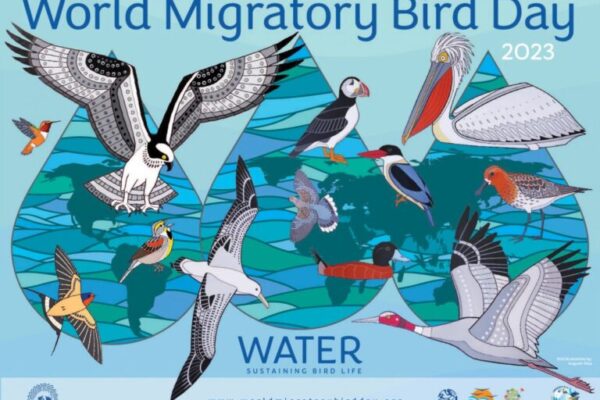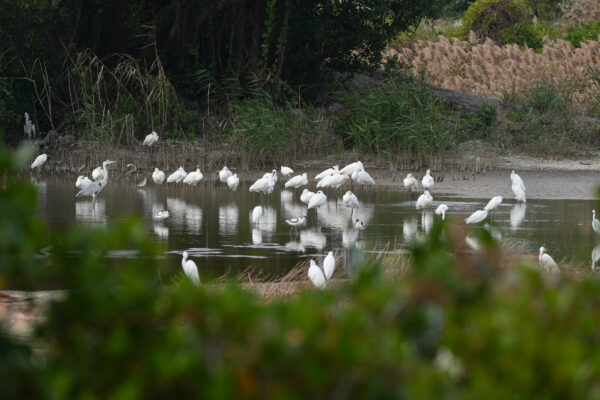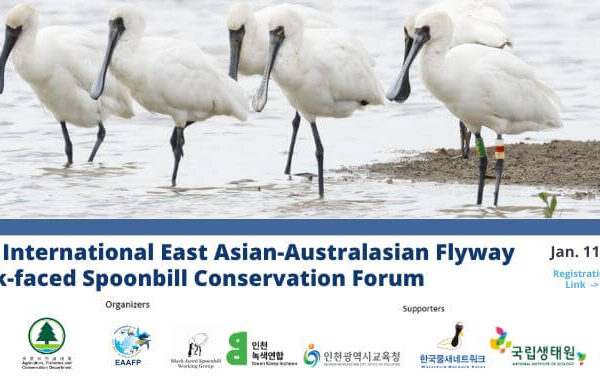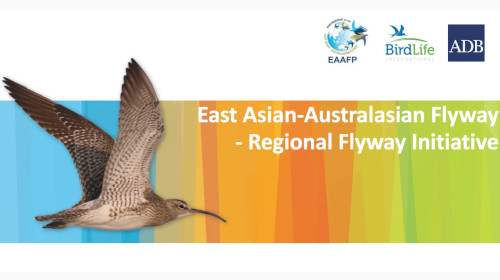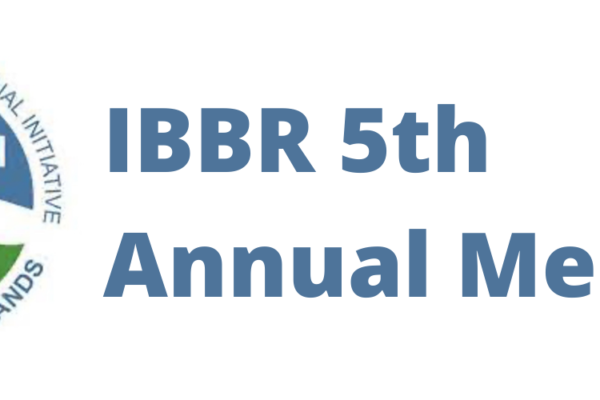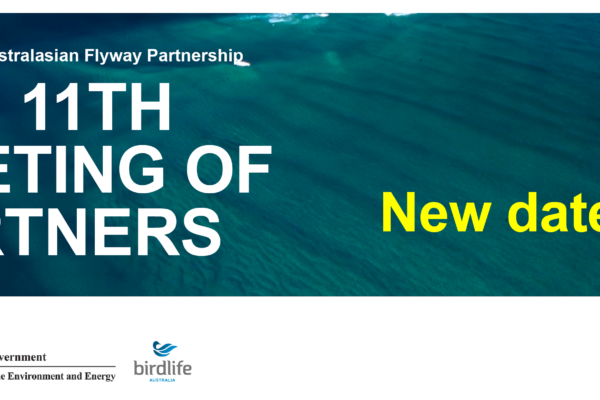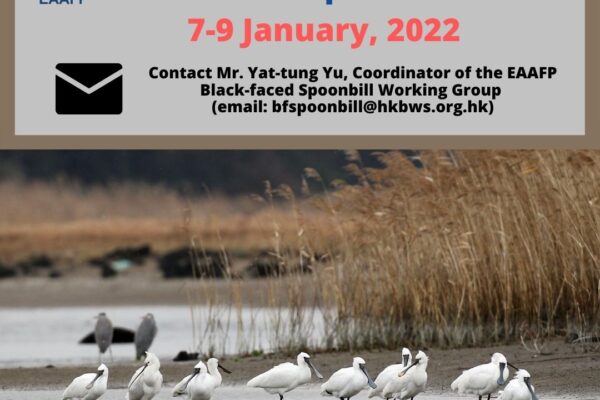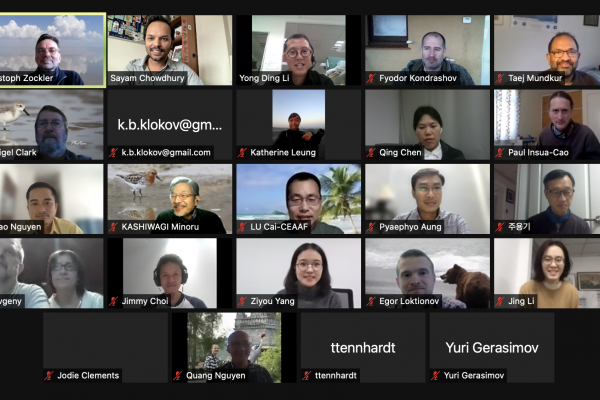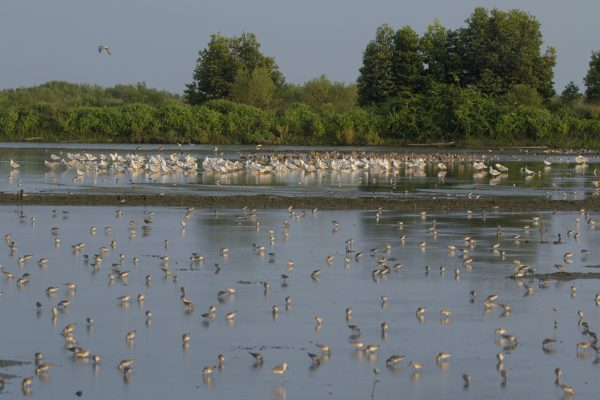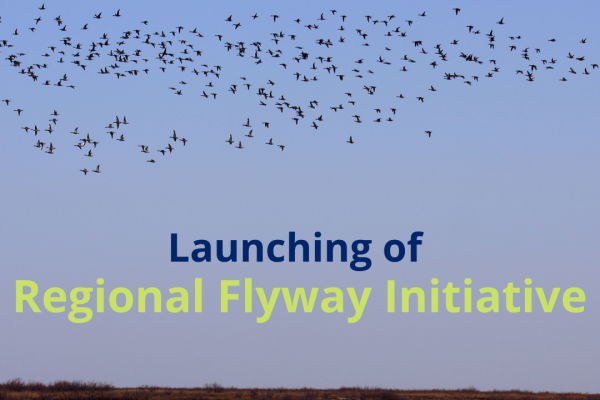-
World Migratory Bird Day 2023 highlights impact of the growing water crisis on migratory birds
BOULDER/BONN/INCHEON, 13 May 2023 – Water and its importance to migratory birds – and the increasing threats to both water quality and quantity - is the focus of this year’s World Migratory Bird Day, a global campaign that aims to raise awareness of migratory birds and the need for international cooperation to conserve them. Activities to mark the campaign will be held globally on two peak days in May and October under the theme “Water: Sustaining Bird Life” Water is fundamental to sustaining life on our planet. Migratory birds rely on water and its associated habitats—lakes, rivers, streams, ponds, swamps, marshes, and coastal wetlands—for breeding, resting, refueling during migration, and wintering. Yet increasing human demand for water, along with climate change, pollution, and other factors, are threatening these precious aquatic ecosystems. Headlines around the world are sounding alarm: 35 percent of the world’s wetlands, critical to migratory birds, have been lost in the last 50 years. Utah’s Great Salt Lake, the largest saltwater lake in the Western Hemisphere and used by more than a million shorebirds, is in danger of disappearing within five years. Across the Amur-Heilong Basin in Asia, climate change is amplifying the impact of habitat destruction by depleting natural water systems and depriving migratory birds of vital breeding and stopover site. These sobering examples go hand-in-hand with recent reports that reveal that 48 percent of bird species worldwide are undergoing population declines. Another poignant example is that of the Aral Sea shared by Kazakhstan and Uzbekistan. Once the fourth-largest lake in the world, it is widely regarded as one of the planet’s worst water-related environmental disasters. Soviet-era irrigation projects almost completely dried up the lake, which led to the loss of livelihoods for fishermen and farmers and the deterioration of public health due to toxic dust and reduced access to clean water. The impact has been severe for the communities around the lake, but also for migratory birds, which lost important food sources and a critically important stopover point on their journey. Another example is the Sahel, a vast semi-arid region in Africa: Prolonged periods of drought, deforestation, and overgrazing in the Sahel have led to the degradation of the soil and loss of vegetation, threatening the survival of both the local human population and wildlife, including migratory birds. Lake Chad, one of the largest water bodies in Africa in 1960, lost 90 % of its area, depleting water resources for local communities and also for many migratory birds. World Migratory Bird Day serves as an international call to action for the protection of migratory birds, whose ranges often span multiple countries, and are facing many different threats worldwide. The annual campaign is organized by the Convention on the Conservation of Migratory Species of Wild Animals (CMS), the African-Eurasian Migratory Waterbird Agreement (AEWA), Environment for the Americas (EFTA), and the East Asian-Australasian Flyway Partnership (EAAFP). World Migratory Bird Day 2023 will be officially held on 13 May and 14 October. The two days of World Migratory Bird Day reflect the cyclical nature of bird migration as well as the fact that there are varying peak migration periods in the northern and southern hemispheres. Events to raise awareness of migratory birds and the importance of water will take place all over the world including in local parks, nature centers, museums, libraries, schools, and other locations on these peak days and throughout the year. To learn more about this year’s World Migratory Bird Day campaign and actions to take, visit www.worldmigratorybirdday.org and EAAFP WMBD 2023 webpage: https://www.eaaflyway.net/world-migratory-bird-day-2023/ Also, please have a look of the Campaign Strategy for promoting World Migratory Bird Day, click [here]. For more resources, visit the Trello Board [here]. Message from the Partners of World Migratory Bird Day Convention on Migratory Species (CMS) “Water is essential for people as well as for migratory birds and other wild species of animals. Yet around the world, the availability and quality of water is under enormous pressure, with deeply concerning implications. The looming global water crisis requires urgent action by governments, businesses, local communities as well as individuals. Because migratory birds cross national borders and even continents, international cooperation is essential to ensure that actions are taken to conserve and restore important habitat for migratory birds, and to address the drivers of water loss, pollution, and climate change,” said Amy Fraenkel, Executive Secretary of the Convention on the Conservation of Migratory Species of Wild Animals (CMS). African-Eurasian Migratory Waterbird Agreement (AEWA) “The water crisis recently highlighted by the UN 2023 Water Conference also has a tremendous impact on migratory birds. In the Sahel in particular, many wetlands on which migratory waterbirds rely during the non-breeding period are shrinking. Water is a vital resource for all, local communities as well as birds. By reducing our consumption, combatting climate change, and managing wetlands wiser, we can improve the situation,” said Dr. Jacques Trouvilliez, Executive Secretary of the Agreement on the Conservation of African-Eurasian Migratory Waterbirds (AEWA). Environment for the Americas (EFTA) “World Migratory Bird Day 2023 spotlights the vital role that water plays in the survival of our shared birds. The focal species illustrated on the campaign poster depict the intricate bond each bird shares with water. The diminutive Rufous Hummingbird thrives on nectar-producing flowers that rely on water for their blooms, and the Dickcissel scours the grasslands for seeds that hold the moisture they need. White Pelicans and Ospreys seek their prey in freshwater lakes, while the magnificent Wandering Albatross and Atlantic Puffin remain at sea. WMBD is an opportunity to unify our voices for the conservation of migratory birds and to celebrate their spectacular journeys,” said Dr. Susan Bonfield, Executive Director at Environment for the Americas (EFTA). East Asian-Australasian Flyway Partnership (EAAFP) “This year's WMBD theme serves as a vital reminder of the linkage of migratory birds to the importance of protecting aquatic ecosystems and conserving wetlands. As birds such as threatened Spoon-billed Sandpiper, Dalmatian Pelican, and Sarus Crane migrate, they rely heavily on wetlands for survival. We must take urgent actions and collaborate at all levels, from citizens to among governments, to tackle the problems of saving water and aquatic ecosystem, and ensure that migratory birds continue to thrive.” Ms. Yeounhee Ahn, Deputy Executive of East Asian-Australasian Flyway Partnership (EAAFP).
Continue reading -
Global population of Black-faced Spoonbill continues to break new record
© Jay Kong/HKBWS Coordinated by EAAFP Partner, The Hong Kong Bird Watching Society (HKBWS), the International Black-faced Spoonbill Census 2023 was conducted from 6th to 8th January 2023. Global population of Black-faced Spoonbills (BFSs) reaches another record high of 6,603, a rise of 7.2% (i.e. 441 individuals) from last year. However, 299 individuals were recorded in the Deep Bay area across Hong Kong and Shenzhen, which is 70 individuals less compared to last year. The number shows a decline of 11% and 19% from 2021 and 2022 respectively. Steady growth in Taiwan, Mainland China and Korea while moderate decline in Japan and almost 20% drop in Deep Bay The census covered about 130 sites all over the world. Taiwan, Mainland China and the Republic of Korea are the major regions which attribute to the growth in the overall population. Taiwan remains the largest congregation site with 4,228 individuals comprising 64% of the global population. The year-on-year growth is 10.6%. In Mainland China, 1,307 individuals and 15.1% year-on-year growth were recorded. The number comprised 20% of the global population. In Ro Korea, the number of BFS reaches 54 individuals with an increase of 45.9%, i.e. 17 individuals. Contrarily, in Japan 610 individuals are recorded which shows a decline of 10.7% from last year, i.e. 73 individuals less. The results this year shows that the global population of Black-faced Spoonbills has increased steadily. The numbers in Taiwan and Mainland China have been setting new records in recent years, which suggests the conditions in those habitats are favourable for a larger number of Black-faced Spoonbills to stay or to gather. Favourable conditions may refer to a safe environment, and sufficient food sources in nearby feeding grounds. The decline in Japan might be related to the loss of stopover sites and the outbreak of bird flu, according to local experts. In Deep Bay area, 299 individuals were recorded, which is the second lowest record in the last decade. Compared to last year, there were 70 individuals les, that is 19% decline. Having reached its record high of 462 individual in 2010, the number of BFS in Deep Bay has not advanced since then and remained above 300 from 2016 until it dropped to 299 this year. The result this year is worrying. Fig. 1 Black-faced Spoonbill Census results 1989-2023 © HKBWS Fig. 2 Black-faced Spoonbill Population size and distribution © HKBWS Fig. 3 Black-faced Spoonbill Census results regional breakdown 1989-2023 © HKBWS The problem of habitat degradation must be confronted, and conservation should be prioritized in the Northern Metropolis Development Strategy The decline in the number of Black-faced spoonbills in Deep Bay area is alarming to Hong Kong. Black-faced Spoonbills mainly forage in the intertidal mudflats of Deep Bay, shallow waters in Gei Wai, and drained fishponds. As the Ramsar Wetland in Mai Po Inner Deep Bay is relatively adequately protected by law, these habitats can be maintained in relatively good conditions. However, the habitats outside the nature reserve are facing different threats. Without immediate measures, they may become unsuitable for Black-faced Spoonbills to loaf and feed. For instance, the expansion of mangroves, including the invasive species Sonneratia caseolaris, continues to eat up the mudflats resulting in a reduction in the habitat available to Black-faced Spoonbills. On the other hand, nearly 30% of the fishpond wetlands and the buffer zones in Deep Bay are hoarded by real estate developers or held privately. These lands have been abandoned or the land use has been altered, which continuously causes habitat degradation in the Deep Bay area. If proactive conservation and management actions are not taken immediately, there is a risk for losing these important winter habitats of the Black-faced Spoonbills’. In order to protect the Black-faced Spoonbill, many countries and cities put great effort into different conservation actions in the past 30 years, and finally the decline of the species is successfully reversed. "It is especially important to establish comprehensive protection laws, long-term conservation strategies and good land use planning, which can restore endangered species and even biodiversity around the world." Mr. Yu Yat-tung, Director of The Hong Kong Bird Watching Society, continued, "The future of the Deep Bay wetlands is determined by the conservation and planning of the Northern Metropolis Development Strategy. To protect the ecological integrity of this internationally important wetland, the Northern Metropolis must comply with the guidelines to protect "Wetland Conservation Area" and "Wetland Buffer Area". The wetland conservation park system must fully cover the "Inner Deep Bay and Shenzhen River catchment area" Important Bird Area recognized by BirdLife International, and ensure them to be protected by stricter laws and regulations; also a management model that is people and ecology oriented must be applied.” Hong Kong is responsible for the proper protection of wetlands and biodiversity, the maintenance of the important ecological corridors for migratory birds, and the assistance to China in fulfilling its obligations under the “Convention on Biological Diversity” and the “Convention on Wetlands”. The Hong Kong Bird Watching Society hopes that the Northern Metropolis can practice "ecological priority", through proper management and conservation of the Deep Bay wetlands, turn crisis into opportunity, and maximize the benefits of bird conservation. Fig. 4 Trend of Black-faced Spoonbill population in Deep Bay © HKBWS About The International Black-faced Spoonbill Census Black-faced Spoonbill is listed as "Endangered" on the International Union for Conservation of Nature's (IUCN) Red List of Threatened Species. The International Black-faced Spoonbill Census takes place every January ever since it was first launched in 1994. During Census 2023, more than 200 veteran birdwatchers, conservationists, researchers and ornithologists were mobilized to record the number of wintering Black-faced Spoonbills at about 130 sites. Reposting of news article from Hong Kong Bird Watching Society with permission, original article (link). Learn about EAAFP Black-faced Spoonbill Working Group: https://www.eaaflyway.net/black-faced-spoonbill-working-group/
Continue reading -
The 3rd Incheon-Hong Kong International East Asian-Australasian Black-faced Spoonbill Conservation Cooperation Forum
11th 13:30 to 13th January 2023 (KST) *Note: The forum will ONLY be open to registered participants As one of the events under the…
Continue reading -
Official Launching of the Regional Flyways Initiative Webpage
The EAAFP Secretariat is pleased to announce the release of a webpage built up for the Regional Flyway Initiative (RFI). The page was set up to archive RFI-related documents, articles, media, and events for information sharing. A brief introduction of RFI, key documents (RFI Technical Assistance Report and EAAFP Strategic Plan 2019-2028), a list of meetings and webinars, articles, and publications linked to RFI are also available. Link: https://www.eaaflyway.net/regional-flyway-initiative/ The Regional Flyway Initiative was launched in October 2021 by joint efforts with Asian Development Bank, EAAFP, and BirdLife International at the Ecological Civilization Forum of the 15th Conference of Parties to the Convention on Biological Diversity (CBD COP15). The Regional Flyway Initiative seeks to develop a long-term financing program to protect and restore EAAF wetland ecosystems and the services they provide. RFI aims to mobilize large-scale financing to support the protection, maintenance, and restoration of wetlands in East and Southeast Asia, especially coastal wetlands. The initiative aims to strengthen the conservation and sustainable use of wetlands across the region, which are crucial for the livelihoods of hundreds of millions of people and the migratory waterbirds in Asia and the Pacific. This will be achieved through partnerships among governments, non-government organizations, local communities, regional organizations, development agencies, private sectors, and other stakeholders.
Continue reading -
EAAFP MOP11 – 4th Notification to Partners
With regards to the continuing COVID-19 global pandemic situation, international travel measures and restrictions imposed in many Partner countries, the Australian Government and BirdLife Australia have proposed revised dates regarding the hosting of MoP11 to the 12th -17th March, 2023 in Brisbane, Queensland, Australia. The EAAFP Management Committee has accepted the generous hosting offer from the Australian co-hosts. The Management Committee also endorsed the Secretariat organizing a series of webinars to increase dialogue with and between Partners. This is also an opportunity for Partners to be briefed on important issues to be tabled for consideration at MoP11, including Activities of the Secretariat; Draft Guidelines for National/Site Partnerships and Sister Site Programme; Migratory Waterbird Conservation Status Review; Update on the ADB Regional Flyway Initiative; Briefing on the proposed Partner Reporting Template for MoP 11, etc. The webinars are proposed for June, 2022. Further notification and details will be announced in due course. The EAAFP Secretariat regrets any inconvenience caused by the postponement of MoP. The Secretariat will continue its work and update Partners, Working Groups and Task Forces on issues and the proposed decision papers related to MoP11 via email, the MoP11 webpage , and social media channels. Please feel free to contact the Secretariat at secretariat@eaaflyway.net for any relevant inquiries.
Continue reading -
2022 International Black-faced Spoonbill Census
Black-faced Spoonbill is arriving at their wintering grounds. The EAAFP Black-faced Spoonbill Working…
Continue reading -
Spoon-billed Sandpiper Task Force meeting 2021
Drafted by The Spoon-billed Sandpiper Task Force The Spoon-billed Sandpiper Task Force of The East Asian-Australasian Flyway Partnership (EAAFP) completed a two-days online meeting between 24 and 25 November…
Continue reading -
An uncertain time ahead for migratory waterbirds in South-east Asia
Sandwiched between the land masses of East Asia and Australia, South-east Asia lies near the geographical heart of the East Asian–Australasian Flyway, an important migratory corridor used…
Continue reading -
Official Launching of Regional Flyway Initiative
On 14th October, The East Asian-Australasian Flyway Partnership (EAAFP), in cooperation with the Asian Development Bank (ADB) and BirdLife International today launched the Regional Flyway Initiative (RFI), a long-term…
Continue reading
- 1
- 2

